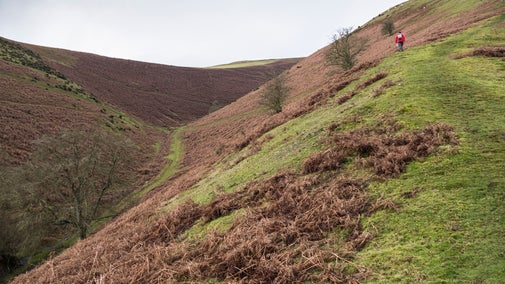
Discover more at Carding Mill Valley and the Long Mynd
Find out how to get to Carding Mill Valley and the Long Mynd, where to park, the things to see and do and more.

Water is all important to Carding Mill Valley. It shaped it, it powered its industry, and it is home to a wide variety of wildlife. Today it is the thing many people visit to see, but how much do you know about the river?
Many people don't even realise the river that runs through Carding Mill Valley has a name, the Ashbrooke. The Ashbrooke has been used by humans for more than a millennia. The first recording of a watermill here was in the Domesday Book. The mill became the Carding Mill in the 1800s, processing the local wool from Long Mynd sheep. The mill finished operation in the late 1880s.
‘River or stream?’ is a daily discussion in the valley. Geographers classify it as a river, but when the level is low and trickling along, the temptation to call it a stream is strong. Then a storm passes through and the clear trickle becomes a raging torrent - it's very much back to being a river.
Wildlife in and around the stream is specialised. The resident dippers and the summertime visiting grey wagtails love its fast-flowing waters. They feed on the many invertebrates who spend the majority of their lives in the cold flow. The dippers build nests close to the river edge, a perilous position when summer downpours arrive.

Mayfly, stonefly and caddisfly larvae all crawl along the rocks for many years before a short finale in the open air on warm days. The caddisfly larvae build cases from river debris to protect themselves, making it look like the leaves have legs. Dragonfly larvae are also at home on the Ashbrooke. This insect life is a key indicator of the Ashbrooke's health and the National Trust's ecology team monitor the species levels and variety regularly.
The fish that live in the river are specialised too. The bullhead or miller's thumb gets its name from its wide head. It likes the coolness and speed of the Ashbrooke and can be found under rocks all year round. Brown trout are harder to spot. They favour the deeper pools and can be seen cruising on quiet, sunny mornings or afternoons.
The river is alive with species, but it is almost alive itself. A heavy downpour increases its power, sounds and speed. These weather events can alter the course of the river drastically, although the various flood measures in place control most of the danger. The days after a period of heavy rain are a great time to walk the length of the Ashbrooke and study its channel changes. Banks can collapse and huge beaches of stone can be deposited.

The Lightspout waterfall was an early tourist hotspot, marketed as a 'mini-Niagara' by the Victorians. If the river is roaring then Lightspout belies its name. It's also a real spectacle on a cold winter morning, when the waterfall freezes in time and forms large icicles.
Above the waterfall, the landscape changes dramatically and the river bubbles and babbles. A short walk brings you to the source of the Ashbrooke. A damp, marshy mire seems a modest way for such an important feature to begin.
Though the industry has long since gone, the Ashbrooke continues to be used and appreciated by wildlife and visitors alike, particularly on warm sunny days.

Find out how to get to Carding Mill Valley and the Long Mynd, where to park, the things to see and do and more.

Enjoy the great outdoors at Carding Mill Valley and the Shropshire Hills. Find out about the best routes and keeping yourself safe while out walking and cycling on the Long Mynd.

Explore the great outdoors at Carding Mill Valley and the Long Mynd. Enjoy a bracing walk, a challenging bike ride, a wild swim, have fun with the family or just take in the views.

The Long Mynd is an area of Common Land, find out more about how this historic grazing pattern has created a special ecology and habitat and the animals you might see.